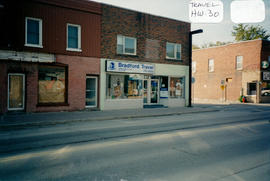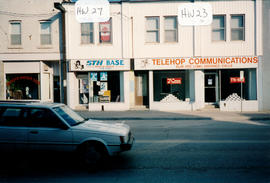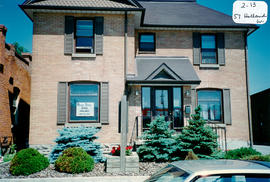12 and 16 Holland Street West - Sutherland's Grocery
- CA BWGPL GJ-HB-2017-03-28-04
- Pièce
- 1995
Fait partie de George Jackson fonds
Sutherland’s Grocery Store was once found at 12 Holland St. West (site of Karen’s and Tina’s Flowers in this 1995 photo). Alec Sutherland was a baker. He had a bakeshop on the south side of Simcoe St. that was run for many years by his daughter Jessie and sister Mrs. Bessie Ryan (and her daughter Betty). They eventually retired and moved to St. Catherine’s. There were living quarters upstairs. William Compton and his wife bought the store and ran it as an IGA grocery store. Gord and Marilyn Compton later took over the store. They built a new store on John St. (where Frank Kilkenny’s house had been). The Comptons’ store eventually moved to what was known as the IGA plaza (located at the corner of Collings Ave. and Holland St. West). As of 2014, 12 Holland St. West is the site of The Holland Bloom florist shop. (1, 2)
The two-storey, commercial, ‘row’ building located mid-block on the south side at 16 Holland St. West was built around 1872-1899 in the Ontario Vernacular style. The second floor had space for offices or living quarters. Whimster and Wilcox operated a clothing and garment store at this location many years ago. Charles Wilson worked for them. John McDowall moved to the area from Midland and ran a clothing store there sometime in the 1930’s or 1940’s. He had three children (Norrie, Jack and Pat). They lived in quarters above the Bank of Commerce and later moved to the apartment over the store.
The building has a wide, rectangular plan with a symmetrical organization. ‘Main street’ frontage with a typical, storefront façade is located at the street line. The symmetrical, three-bay façade originally had a high, articulated cornice of corbelled and dentilled brick (typical of rich detailing). Its ground floor was characterized by the rhythm of flat pilasters along the street edge. The existing doors and storefront are not original. Three, large window openings with segmented arch openings and concrete lug sills at the second-floor level have been partially filled. The windows are also not original. Built-up tar and gravel covers the flat roof. Masonry construction with brick cladding has been considerably altered in appearance. It is also no longer the site of Carmen’s Backyard Restaurant, as seen in this photo from 1995. (1, 2, 3)
Sans titre










